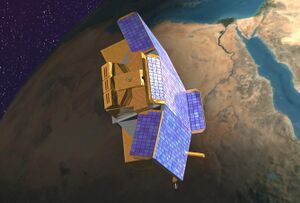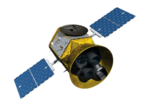Astronomy:CHIPSat
 Artist's impression of the CHIPSat spacecraft | |||||
| Mission type | Astronomy | ||||
|---|---|---|---|---|---|
| Operator | NASA | ||||
| COSPAR ID | 2003-002B | ||||
| SATCAT no. | 27643 | ||||
| Website | chips | ||||
| Mission duration | Final: 5 years, 3 months | ||||
| Spacecraft properties | |||||
| Manufacturer | SpaceDev Inc | ||||
| Launch mass | ~ 64 kg (141 lb) | ||||
| Dry mass | ~ 40 kg (88 lb) | ||||
| Dimensions | 5 m × 2.8 m × 3.2 m (16.4 ft × 9.2 ft × 10.5 ft) | ||||
| Start of mission | |||||
| Launch date | 13 January 2003, 01:45 UTC[1] | ||||
| Rocket | Delta II | ||||
| Launch site | Vandenberg SLC 2W | ||||
| Orbital parameters | |||||
| Reference system | Geocentric | ||||
| Regime | Low Earth orbit | ||||
| Semi-major axis | 6,919 kilometres (4,299 mi)[2] | ||||
| Perigee altitude | 528 kilometres (328 mi)[2] | ||||
| Apogee altitude | 554 kilometres (344 mi)[2] | ||||
| Inclination | 94.05 degrees[2] | ||||
| Period | 95.5 minutes[2] | ||||
| Epoch | 17 Feb 2020 21:02:45 UTC[2] | ||||
| |||||
CHIPSat (Cosmic Hot Interstellar Plasma Spectrometer satellite, also just CHIPS) is a now-decommissioned, but still-orbiting, microsatellite. It was launched on January 12, 2003 from Vandenberg Air Force Base aboard a Delta II with the larger ICESat, and had an intended mission duration of one year. CHIPSat was the first of NASA's University-Class Explorers (UNEX) mission class and it was also known as Explorer 82. It performed spectroscopy from 90 to 250 angstroms (9 to 26 nm), extreme ultraviolet light.[3]
The primary objective of the science team, led by Principal Investigator Mark Hurwitz, was to study the million-degree gas in the local interstellar medium. CHIPSat was designed to capture the first spectra of the faint, extreme ultraviolet glow that is expected to be emitted by the hot interstellar gas within about 300 light-years of the Sun, a region often referred to as the Local Bubble. Surprisingly, these measurements produced a null result, with only very faint EUV emissions detected, despite theoretical expectations of much stronger emissions.
It was the first U.S. mission to use TCP/IP for end-to-end satellite operations control.
The University of California, Berkeley's Space Sciences Laboratory served as CHIPSat's primary groundstation and manufactured the CHIPS spectrograph, designed to perform all-sky spectroscopy. Other ground network support was provided by groundstations at Wallops Island, Virginia and Adelaide, Australia. CHIPSat's spacecraft platform was manufactured by SpaceDev.
In September 2005 the spacecraft was converted to a solar observatory.[4] From April 3, 2006 to April 5, 2008 CHIPsat performed 1458 observations of the Sun.[5]
Satellite operations were terminated in April 2008.
See also
References
- ↑ "NASA - NSSDC - Spacecraft Details". NASA. https://nssdc.gsfc.nasa.gov/nmc/spacecraft/display.action?id=2003-002B.
- ↑ 2.0 2.1 2.2 2.3 2.4 2.5 "CHIPSat Satellite details 2003-002B NORAD 27643". N2YO. 18 February 2020. http://www.n2yo.com/satellite/?s=27643.
- ↑ Cosmic Hot Interstellar Plasma Spectrometer
- ↑ "Archived copy". http://chips.ssl.berkeley.edu/news.html.
- ↑ CHIPS Solar Science Archive
External links
- "Good-bye Mr. CHIPS", Chris Thompson, East Bay Express, 2 July 2008.
- "CHIPS, the Cosmic Hot Interstellar Plasma Spectrometer". University of California, Space Sciences Laboratory. http://chips.ssl.berkeley.edu/.
- "Two Years of EUV Observations with the Cosmic Hot Interstellar Plasma Spectrometer". University of California, Space Sciences Laboratory. http://chips.ssl.berkeley.edu/AAS200512abstract.txt.
- "SpaceDev Small Satellites". SpaceDev. http://www.spacedev.com/spacedev_micro_nano_sats.php.


